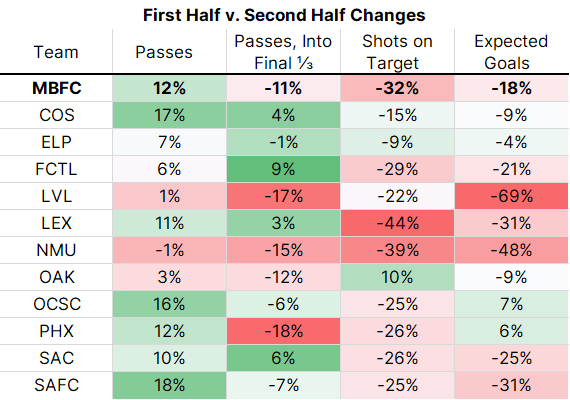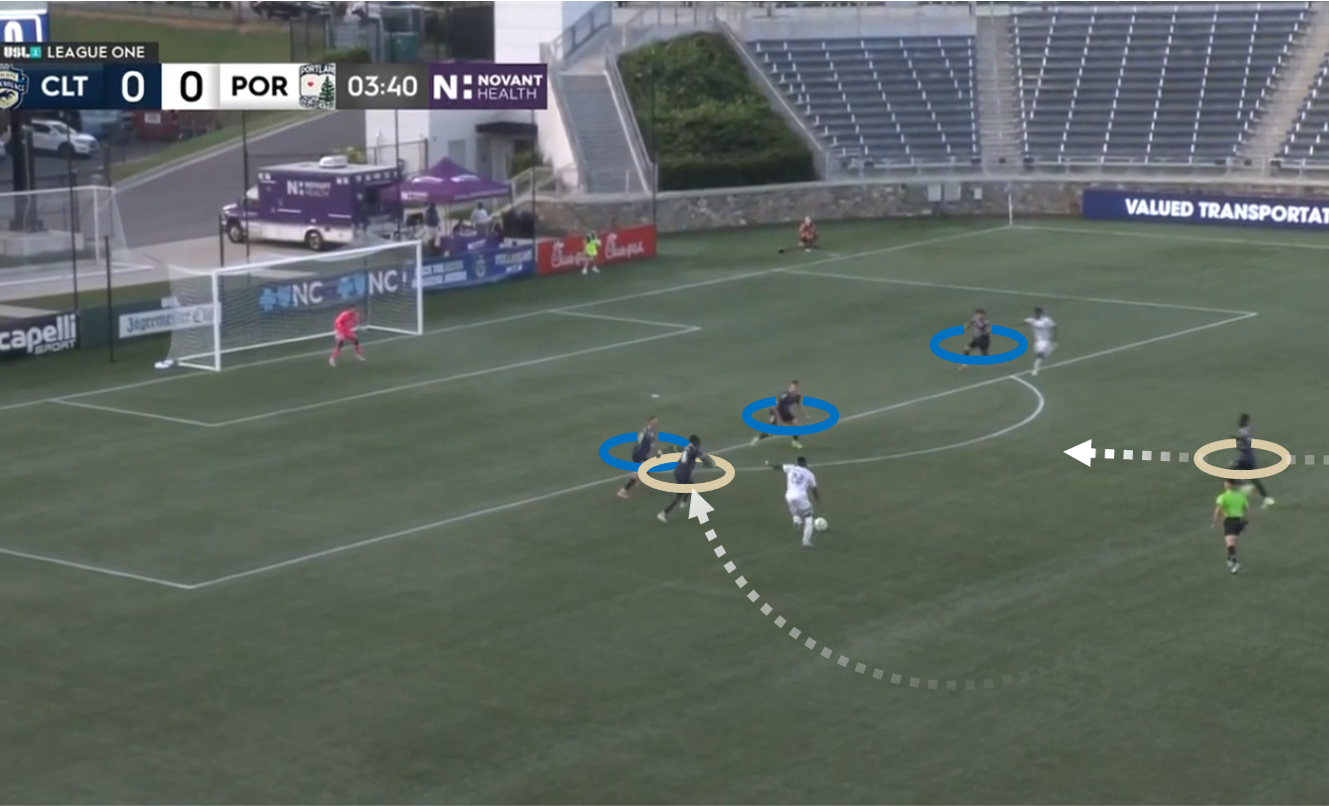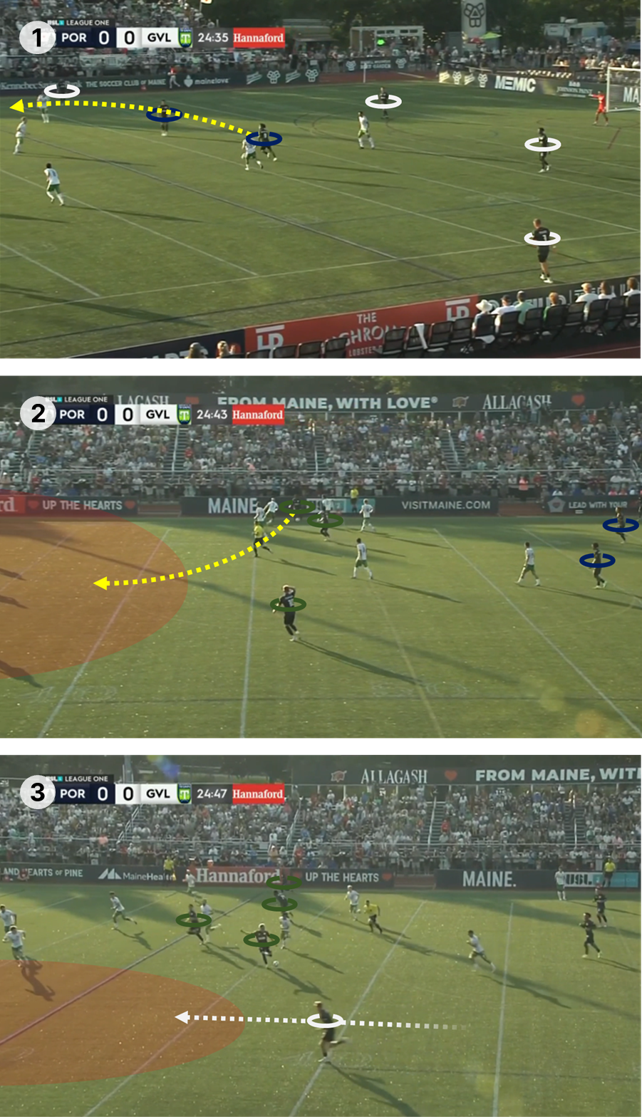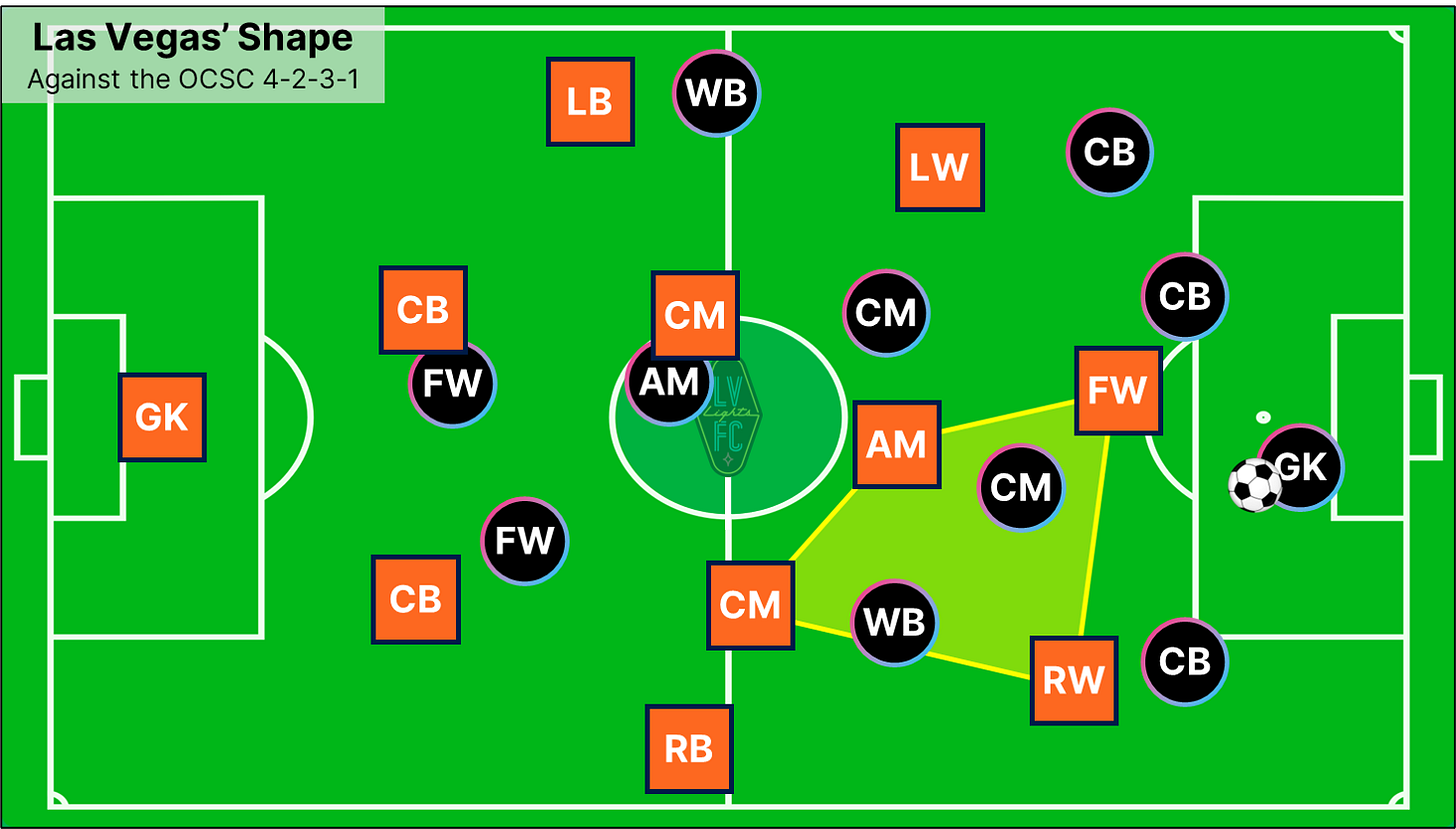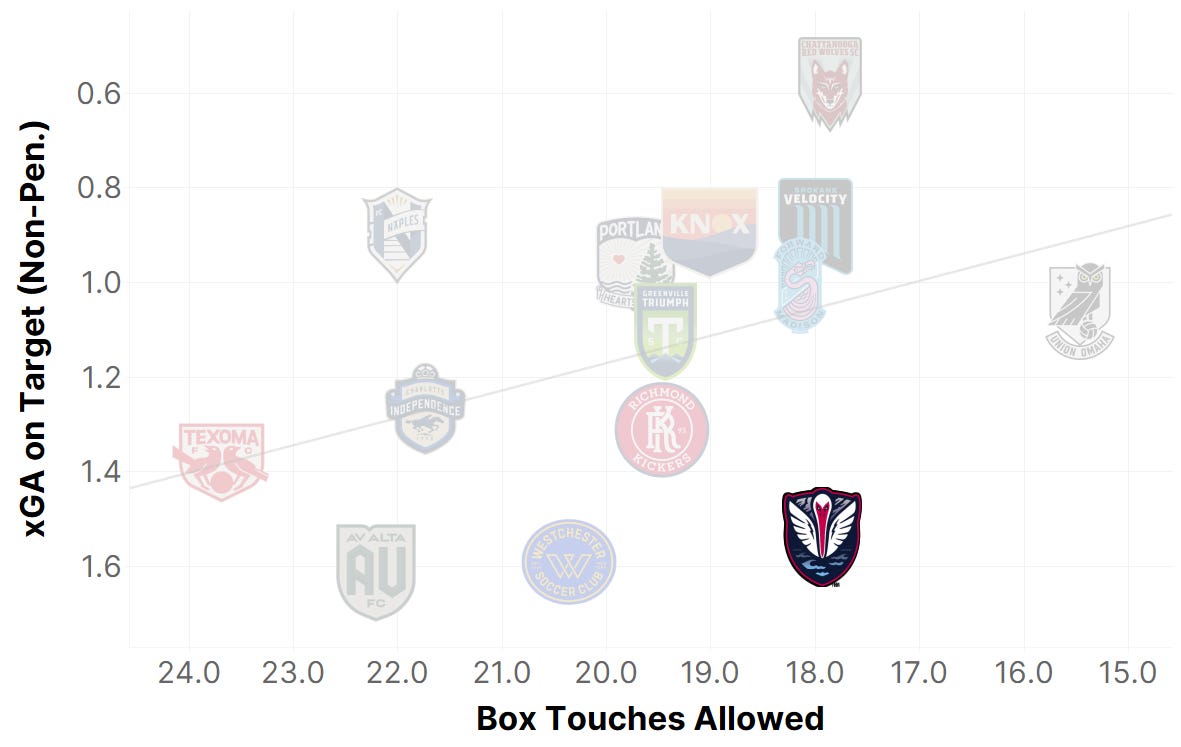Welcome in to The Back Four, where I’m writing more blurbs than advertised!
Before we start, check out Backheeled for Oakland’s glow-up, three crucial points for Colorado Springs, and more. You can also find This League! on the site for an audiovisual dive into the week that was.
Without further ado, let’s get to it.
Tampa Bay, turning the corner?
I don’t believe in the “new manager bounce.” Most of the time, the improvements you get under a recently-hired coach are simple regressions to the statistical mean after a bout of underperformance.
I’m more willing to lend credit to a manager when they’re actively making changes. Early into the Dom Casciato era in Tampa Bay, change hasn’t come wholesale, but we’ve seen enough innovation already to feel justifiably hopeful.
Now, to level-set right off the bat: it’s not been great. The Rowdies used a minimally changed lineup in San Antonio in Casciato’s debut and, despite a few tweaks in terms of pressing shape, lost a match in which they mustered just 0.78 xG. Last Wednesday in Hartford, Tampa Bay earned three points despite a similarly meager output.
Still, it’s useful to hone in on specific moments and passages within Casciato’s 180 minutes at the helm. In particular, the second half in Connecticut held promise. There, Tampa Bay used a 57th minute triple change to get Joey Skinner, Nick Moon, and Woobens Pacius into the match. The result? A winning goal and merely three shots allowed in the final 30-plus minutes.
We’ll get to the fresh faces in a minute, but Casciato didn’t stop with the subs. Tampa Bay began the match in a 3-4-3 with Thomas Vancaeyezeele as their right wingback and Laurence Wyke as their right-sided central defender. After the halftime break, they traded spots – a move that activated Wyke’s superior passing ability to the utmost.
Put it all together, and you got something far livelier than we’d seen from Tampa Bay in 2025.
Consider the play here, where Wyke passes around a closing defender and hits Moon on the right wing. In isolation, it’s a pass that might pin Moon and lead to an immediate turnover. Instead, Vancaeyezeele – far better as a later-arriving underlapper than a provider of true width – makes an ingenious third-man run and nearly sees the Rowdies into the 18-yard area.
The execution is a few degrees away from perfect, but it’s a lovely encapsulation of Casciato’s originality. Wyke had an excellent second period; he used a near-identical situation like this in the 66th minute to play Moon directly into the box.
Moon himself looked positively predatory in a true wing deployment as he and Pacius combined to take 68% of their side’s box touches. Skinner was impactful as well, proving to be a willing dueler that pinned the hosts back and improved the field tilt. Using natural wingbacks like Moon and Skinner that high upfield might’ve seemed odd, but it worked.
To an extent, Tampa Bay improved because Hartford took their foot off the gas. Still, it’s hard not to feel excited about the new patterns and deployments that Dom Casciato brought to the table. For all their foibles, the Rowdies are just four points off the playoff cut-line, and their ceiling under new management is quickly on the rise.
Monterey’s mid-game fades
Between Backheeled and my recent guest spot for The Union Report, I’ve had a lot to say about Monterey’s width and structure – or lack thereof – in recent weeks. All the while, I haven’t quite been able to nail down what’s nagging at me about this team.
Wednesday’s loss to FC Tulsa was a clarifying moment. For the first 45 minutes, Monterey had a particular balance that allowed them to defend in a structural 4-4-2 but attack with gumption on the wings. Mayele Malango got a goal from the left side and underpinned that success. Despite holding just 29% of possession, things felt right for MBFC.
Then, the second half. Monterey conceded twice in the first three minutes after the break, then they failed to put a single shot on net while on the comeback trail. We’ll get into the specifics, but it’s useful to anchor the discussion in a trend of post-halftime deflation.
Across 2025, Monterey has performed far worse in second halves. It’s difficult to separate these sorts of statistics from game states – are you leading or trailing, and what impact does that have on your style? – but still can paint a picture.
Jordan Stewart’s side tends to complete more passes overall after the break, but their returns in terms of final third entries, shots on target, and xG all crater. Anecdotally, it feels like Monterey either shells into an overly defensive posture or gets away from their marauding, vertical apex late in matches. The numbers bear that theme out.
In Tulsa, Stewart made two halftime changes that left me scratching my head. Up top, Anton Sojberg exited for Adam Larsson. At the back, Carlos Guzman entered for Jacob Muir. Neither substitution had the intended result.
Sojberg is a keen mover at the second striker spot, but he’s also a willing dueler. He’s winning 48% of his battles this year (great for a forward), including 1.3 aerial wins per match. Larsson, by comparison, is sitting at a truly dismal 27% duel win rate. Making that swap against hyper-physical Tulsa left Monterey without a key anchor in the final third.
Tulsa got on the board with a 47th minute corner, one that squeaked over Nico Gordon’s head and met a Tulsa runner in front of Grant Robinson at the far post. Blown coverages happen, but there was a remarkably similar corner taken in the 12th minute that Monterey defended with ease.
The player that cleared the danger in the first half? None other than Sojberg. There’s no guarantee he would’ve done the same later in the match, but you have to wonder. Meanwhile, Monterey has been dismal against defensive set pieces writ large. They’ve allowed 10 goals from dead balls in 2025, dead last in the Championship.
Addressing the other change, Guzman did an admirable job as a table-setter from the left side of the defense as Monterey chased the game. He’s a player I rate very highly, a natural partner for Gordon. Still, why dispense with Muir – a strong passer himself! – and re-work your back line against an opponent like FC Tulsa that’s so good about sewing chaos?
One result is one result, but it’s a microcosm of Stewart and Monterey getting in their own way. In a wide-open race in the Western conference, it’s the sort of problem that might just prove lethal.
Charlotte’s spine
The Charlotte Independence are a deceptive, slippery team to wrap my hands around. It’s easy to fixate on star attackers moving in and out or formational tweaks, but the club’s real strength lies in their consistent core.
Even amidst an up-and-down recent stretch, Charlotte remains in third place because of that spine. Three recent results (a loss versus Omaha, plus draws in Madison and against Portland) elucidate some of the ties that bind Charlotte together – what matters and what doesn’t.
For better or worse, Tumi Moshobane was in the spotlight against Los Búhos. Having just signed from the El Paso Locomotive, Moshobane looked like his classic self in an attacking sense. Four minutes in, he dropped for a touch from the right side of the 4-4-2, drew Omaha in, then froze the defense from the halfspace to allow Clay Dimick to underlap his way into the box. Minutes later, the South African international intercepted a pass headed into Charlotte’s defensive third and waited until the perfect moment to find Rafael Jauregui with a through ball.
That’s Moshobane at his needle-threading best. Less good? His defensive energy, which allowed Omaha to have their way in the channel. Ryan Becher found an abundance of touches behind the new signing’s back, putting Charlotte in a deficit and goading a halftime change to bring Juan Moreno in for Moshobane.
Of course, to blame one single player would be disingenuous. Still, it gets to the core of my thesis: I love Tumi Moshobane as a player, but he’s not the end-all, be-all in North Carolina.
Against Omaha, Independence lacked zhuzh at a team-wide level. This year, Charlotte has generated the second-least final third takeaways (2.4) per match but the sixth-most (17.9) in the midfield. We know this team isn’t going to sell out in the high press, but they need to force takeaways around halfway to stay whole. That didn’t happen often enough in the first 45 minutes a weekend ago.
Four days later in Wisconsin, Charlotte shifted into a defensive back five to match Forward Madison. Across the board, the patterns felt better. With Rafael Jauregui – truly one of the unsung stars of the 2025 season across the USL – doing his thing as a hybrid right-sided wingback, the Independence’s 5-2-3ish shape mostly stopped Madison from penetrating into the halfspaces through their withdrawn forwards. That’s the case above, powered by beautiful rotations up and down the midfield.
You start with the pentagonal front end of the shape – three forwards, two center mids – in action, denying Madison easy access to the central areas. As a result, the hosts have to work toward their right side.
When that happens, winger Souiabou Marou doesn’t close toward the ball. Instead, he trusts left back Pele Ousmanou to do that job and instead marks a third-man run out of the Madison midfield.
That stellar rotation slows Madison down, encouraging them to work back inside on the dribble. You’d worry that Ousmanou might lose the plot so far afield from his baseline position, but that isn’t the case. Instead, central midfielder Bachir Ndiaye hedges his bets perfectly. Ndiaye is high enough upfield to challenge a dribbler, but he can also recover backward if the ‘Mingos try and slip something between the lines.
The result here is a reset – exactly what you want to see if you’re Mike Jeffries.
When Charlotte faltered, it tended to come when Madison worked quickly over the front line of pressure and found a seam. Say that the ‘Mingos chipped over right winger Jon Bakero to find a pocket and drew a closing run from Jauregui; suddenly, there was vulnerability across the back. Those problems were especially marked in the instances where Charlotte upped the ante in the press and hinged ahead toward the Madison box.
With Hearts of Pine in town, Jeffries left Moshobane out of the XI once more, opting for another 5-2-3. Again, it was the responsibility in the midfield, particularly through Ndiaye and Omar Ciss, that stood out. The semi-transitional moments that stung against Madison were far less lethal.
You’re only getting a still image here, but it features Ciss having recovered against winger Walter Varela on the break, hemming him back toward the crowded center of the park. Meanwhile, Ndiaye is also getting back, adding yet another layer of support.
Between that midfield excellence (Ciss and Ndiaye combined for 11 recoveries) and a shutdown night for Dimick against Titus Washington’s drifts and Nathan Messer’s overlaps, Charlotte didn’t concede a chance worth more than 0.138 xG.
Meanwhile, Ciss and Ndiaye also showcased an erudite partnership in possession. As of late, Ndiaye has done well to express himself in the halfspace, particularly up the left side. Less of an incisive passer and more of a ball-mover, he went 45-for-53 against Portland. It’s the sort of clean supporting distribution that allows Bakero to be expressive.
So, what have we learned as of late? Maybe not much! I hyped up the additions of Pedro Fonseca and Tresor Mbuyu about a month ago, and I came into last weekend watching Tumi Moshobane with bated breath. That’s missing the forest for the trees when it comes to Charlotte. The Independence remain in a top-four spot because of their familiar stalwarts – the Cisses, Ndiayes, Dimicks, and Nick Spielmans – and the way those players are able to lock matches down.
The Portland template
Portland has quickly defined a very clear style for themselves in League One. Bobby Murphy isn’t precious about possession, optimizing his system around a marked verticality.
So far this year, Hearts of Pine have held 49.6% of the ball. Despite the fact that they’re a tick below league average in terms of their long passing share, Portland plays the second-highest percent of their passes into the final third (32%) of any League One organization. This team is direct without being wasteful.
With that profile in mind, let’s walk through a typical build sequence for Portland Hearts of Pine:
I’m loosely splitting Portland into three lines here. The defensive foursome is marked in white, the midfield pivot pair is in blue, and the forward unit – striker Titus Washington and three attacking mids – is in green.
At the start of this sequence, Hearts of Pine approach Greenville’s press in a 2-4-3-1 shape with both center mids staying low and anchoring possession. In general, Portland wants to quickly work out of their own end, but they understand the utility and safety of a true double pivot in doing so.
Thus, frame #1 sees Michel Poon-Angeron on the ball, pairing with Mikey Lopez to draw the Triumph higher and allow for an entry pass between the lines. The Trinidadian international, ranked relative to his fellow No. 6s and No. 8s, has posted 88th percentile final-third entry passes this year and 98th percentile recoveries. He’s built to regain the ball and swiftly find teammates in useful spaces, and you’re getting a taste of the latter trait here.
Heading into frame #2, Jay Tee Kamara (the right winger) receives beyond the initial waves of Greenville pressure on the sideline. Kamara is roughly level with Masashi Wada and Ollie Wright, who’ve intentionally positioned themselves to either break lines (in a vertical sense) as receivers or to provide next-step options to switch the point (in a horizontal sense) and keep progress going.
When Kamara gets a touch, he draws pressure from Greenville. The Triumph rotate toward Portland’s right side, which means that there’s a gap opening on the left.
Hence, you get what’s happening in frame #3: the point begins to switch. Washington receives from Kamara, then he lays the ball off toward Wright in the center of the park. All the while, Nathan Messer has flown upfield from left back to take advantage of the defense-bending sequence.
If that’s all too esoteric, you can see it play out in video form here:
Messer’s cross might not be lethal in the end, but it’s the pay-off of principles that we see every single week from this Hearts of Pine team.
Against Greenville, Portland’s first goal came via Messer in the wake of a quickly-taken set piece, which set Wada up close to the net for a tap-in. A minute later, Hearts of Pine doubled up by playing directly into Titus Washington after a Mikey Lopez takeaway at the No. 6 spot. There might’ve been a goalie error fueling that second finish, but it was still a bright evocation of Portland soccer.
Saturday’s draw in Charlotte was decidedly less bright, partially due to a continuing commitment to heavy squad rotation. Murphy knows that his press is demanding, and he’s been willing to wholly swap out his attacking lines when Hearts of Pine have faced down Wednesday/Saturday doubles. That was very much the case over the weekend.
Re-creating the spark we saw against the Triumph was a chore until Wright came into the game in the 63rd minute. Up to that point, Portland had only attempted two shots. Thereafter, they put up six attempts in less than half an hour and accrued 84% of their total xG – not to mention Messer’s equalizing goal. If nothing else, it’s clear that Portland’s got the goods with their best XI in tow, and it all boils down to their vertical style of play.
Las Vegas’ blight
There’s been a lot of discussion of Las Vegas’ improvements under Giovanni Troise, particularly around the club’s re-emphasized attack. The narrative is partially true: the Lights are far more fun to watch these days than they were under Antonio Nocerino. The actual outcomes? Shockingly static.
Consider a few key numbers from the Nocerino era as compared to the five league games since then:
Expected Goals per 90 – 0.901 under Nocerino, 0.898 under Troise
Passes per 90 – 360 under Nocerino, 366 under Troise
Long Passing Share – 17.3% under Nocerino, 17.2% under Troise
Crossing Share – 2.4% under Nocerino, 2.0% under Troise
Throw away the eye test, and the changes are vanishingly minimal. The Lights are ever-so-slightly less direct, but their underlying outcomes have largely stayed the same. Meanwhile, the floor has continued to fall out on a defense that’s allowed four goals in back-to-back weeks.
Now, I want to hedge and acknowledge that the stats are a bit misleading. Las Vegas has a tendency to collapse after they’ve gone down by a goal or two – it’s an “avalanche” effect where a single error leads into a cavalcade, tanking Troise’s style along the way.
In more even game states, a 3-4-2-1 shape with far more verve and complexity than Nocerino ever wrought has prevailed. You see as much in the example here.
Against an uncharacteristically light FC Tulsa press, Las Vegas builds around the back with three center backs and two pivot players. The depth of those center mids, Valentin Noel in particular, forces the second line of opposing pressure to step up. At the same time, it encourages the first line to hedge their bets, sitting a step deeper in order to shadow Noel and deny a central angle.
Under Nocerino, this play would’ve resulted in a long outlet pass before the press-bending movement had time to develop. Here, there’s far more patience, and it opens up a clean, grounded ball into striker Johnny Rodriguez’s feet between the lines.
This is where the fun begins. Rodriguez holds up play, bringing wingback Gennaro Nigro into the move as he tucks inside. Nigro is taking a colossal 64 touches per game this year, often planting himself narrow in the halfspace like a proxy creator. Here, his roaming movement forces Tulsa to bend, freeing a change of point up the right.
Las Vegas ultimately settles for a distant cross, which is a recurring problem. There’s been a lack of incision in the final third, a lot of which I attribute to Noel’s deep positioning. Even so, this is a good sequence! When Nigro first receives, the Lights have ample potential to strike ahead with any number of patterns.
Heading into Week 20, Orange County rightly realized that the key to stopping Las Vegas is to prevent that first line-break. If you make this Troise team sweat from the moment they restart, you’re business. Pursuantly, Danny Stone’s press had an extra layer as compared to Tulsa’s three-level press, and it decisively snuffed out Troise’s patterns.
I’ve mapped that scheme above, highlighting how Noel and the left wingback – Younes Boudadi rather than Nigro this time out – were caught between a rock and a hard place amidst the opposing 4-2-3-1. The initial “Raiko Arozarena passes right toward a center back” step is cut off, and none of the other dominos can fall behind it.
The Lights’ only recourse was to try to play over the press, but their stubbornness allowed Orange County to absolutely feast on the break whenever they forced a turnover against shorter build. On Saturday, the guests’ average defensive action came 51 yards upfield, roughly 20% higher than the USL average. That number was a result of Danny Stone’s cleverness, but it was equally due to Las Vegas lacking any semblance of a “Plan B.”
It was nice while it lasted under Troise – who, admittedly, was suspended and missed Saturday’s match – but something’s gotta give. We’re roughly three months out from the playoffs, and Las Vegas is stuck in a stale, indecisive rut that’s kneecapping their playoff hopes.
Tormenta and chance quality
Expected goals are useful because they add detail. You might look at South Georgia Tormenta, see that they’ve attempted as many shots (169) as they’ve allowed (169) in the league, and assume it’s all hunky-dory.
Dig deeper, and Tormenta has allowed 41% more expected goals (27.5) than they’ve generated (19.5) for themselves. That’s bad!
You can point to multiple root causes for the struggles. This team has spent a lot of time experimenting with personnel up top in ways I’ve liked, but they’ve also failed to nail down a starting center back combo with any modicum of trustworthiness. After putting up two of the best xG-preventing seasons in the history of League One, star goalkeeper Austin Pack has also come back down to earth.
What’s beguiling is how the bad results have come amidst those aforementioned shot numbers and a general ability to tilt the pitch. Tormenta is still fourth in the league in possession, after all.
In terms of preventing touches in the box, Tormenta entered the weekend as the fourth-stingiest team in the USL. You love to see it! Generally, teams that deny box touches also allow less dangerous chances.
Not Tormenta. Using “xG on target against” – the chance a shot will go in based on its location within the frame of the goal – this team is allowing foes to have their way and place shots with too much precision. Tormenta might not be allowing penetration all that often, but they’re giving opponents too much unperturbed time to score when it happens.
Against One Knox a week ago, Ian Cameron’s side led for 54 minutes but gradually let their opponents take over the game. What began as a steady defensive showing devolved into a match where Knoxville completed 99 passes in the final third with 82% accuracy, hammering their way up the middle.
Not all touches in the box are created equal. If you’re allowing for grounded passing up the gut, you’re necessarily going to concede higher-quality opportunities. If penetration comes on the end of crosses, the chances are going to be far harder to convert. Shifting from the former allowances toward the latter was South Georgia’s primary area of growth in a 2-1 win against Union Omaha on Friday.
What you’re seeing here is, in xG terms, the best chance that Omaha generated over the weekend. This play was worth about 0.47 expected goals for Sergio Ors Navarro’s far-post header, essentially a coin flip by the numbers.
To me, that sum feels generous. From the moment Tormenta gives the ball away against the counterpress to Ors Navarro’s whiff at the far post, there’s an overwhelming sense of defensive organization and space denial. The back four – Callum Stretch, Makel Rasheed, Thabo Nare, and Gabriel Alves from right to left – retains a sense of spacing throughout. Gabriel Cabral gets low from the pivot to further tighten the screws. Tormenta allows touches near their goal, but they’re hotly contested all throughout this sequence.
Most of Omaha’s best looks on paper played out similarly. South Georgia, who went a dismal 23% in the air, clearly struggled to win headers outright, but they rarely gave their hosts a free opportunity. Cameron’s 4-4-2 block stayed terrifically narrow, forcing Omaha to whip in crosses and hope for the best. Most of those opportunities came during the 15 minutes on either side of the halftime break, after which point Tormenta restored a better sense of control to see out their lead.
Now, playing with fire around your net means that you’re eventually going to get burned. Tormenta needs to be better at denying penetration, via crosses or otherwise. Still, if they can pull that defensive job off while continuing to develop attacking patterns, they’ll be well-positioned for the home stretch.
Quick Hits
In other news this week…
The USL Show is live from Fitzpatrick Stadium in Portland this week! We’ll be streaming pre- and post-game when Hearts of Pine take on the Pittsburgh Riverhounds on Friday, and we’ll be bringing interviews and analysis amidst one of the best atmospheres in the American game. Tune in!
Cam Lancaster scoring an absolute banger was not on my bingo card this weekend, but you absolutely love to see it. Louisville’s draw against Tulsa was very much a tactical “Spider-Man pointing” game, and even though LouCity needed a banger from their veteran legend to get on the board, they can’t help but feel good about the performance.
JC Obregon is the truth, if you needed reminding. His long-range goal against One Knox was an absolute peach, and it’s become a trend for a Westchester team with nine goals from outside the box – 50% more than anyone else in League One.
The fact that there was a one-off Jagermeister Cup match over the weekend was so confusing for me. That’s partially because I’m dumb, but…like…we really can’t schedule this cup so that the final weekend is uniform and relatively simultaneous? We’re really doing the draw a week-plus before anything is settled?
I’m seeing a 4K restoration of Akira Kurosawa’s High and Low this week, and I’ve never been happier.

